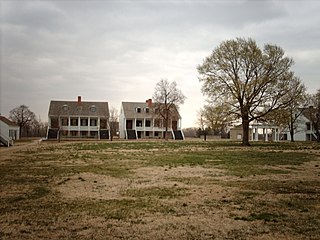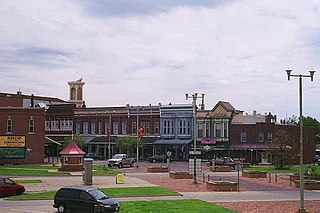Fort Lincoln was established about August 24, 1861, by United States Senator James Lane. Earlier in August, Lane had reestablished Fort Scott as a military post. Soon Confederate troops under Maj. Gen. Sterling Price threatened to overrun the newly reopened post.

The United States Senate is the upper chamber of the United States Congress, which along with the United States House of Representatives—the lower chamber—comprises the legislature of the United States. The Senate chamber is located in the north wing of the Capitol, in Washington, D.C.

Fort Scott National Historic Site is a historical area under the control of the United States National Park Service in Bourbon County, Kansas, United States. Named after General Winfield Scott, who achieved renown during the Mexican–American War, during the middle of the 19th century the fort served as a military base for US Army action in what was the edge of settlement in 1850. For the next quarter century, it was used as a supply base and to provide security in turbulent areas during the opening of the West to settlement, a period which included Bleeding Kansas and the American Civil War.

The Confederate States of America, commonly referred to as the Confederacy and the South, was an unrecognized country in North America that existed from 1861 to 1865. The Confederacy was originally formed by seven secessionist slave-holding states—South Carolina, Mississippi, Florida, Alabama, Georgia, Louisiana, and Texas—in the Lower South region of the United States, whose economy was heavily dependent upon agriculture, particularly cotton, and a plantation system that relied upon the labor of African-American slaves.
Lane moved 1200 troops, most of the citizens of the town of Fort Scott, and some refugees from Missouri to a point 15 miles northwest of Fort Scott. On some low ground on the north side of the Little Osage River, Fort Lincoln was established. The post was named for President Abraham Lincoln. Lane was criticized for choosing such a low spot, because it was difficult to see enemy troops coming and the area was prone to flooding during periods of heavy rains. [1]

Fort Scott is a city in and the county seat of Bourbon County, Kansas, United States, 88 miles (142 km) south of Kansas City, on the Marmaton River. As of the 2010 census, the city population was 8,087. It is the home of the Fort Scott National Historic Site and the Fort Scott National Cemetery. Fort Scott is named for Gen. Winfield Scott.

Missouri is a state in the Midwestern United States. With over six million residents, it is the 18th-most populous state of the Union. The largest urban areas are St. Louis, Kansas City, Springfield, and Columbia; the capital is Jefferson City. The state is the 21st-most extensive in area. In the South are the Ozarks, a forested highland, providing timber, minerals, and recreation. The Missouri River, after which the state is named, flows through the center of the state into the Mississippi River, which makes up Missouri's eastern border.

The Little Osage River is an 88-mile-long (142 km) tributary of the Osage River in eastern Kansas and western Missouri in the United States. Via the Osage and Missouri rivers, it is part of the watershed of the Mississippi River.
The post consisted of a number of buildings surrounded by a 5-foot-high (1.5 m) earthwork embankment. One large blockhouse was relocated to the town of Fort Scott about 1864 to help protect it and the post of Fort Scott. The town of Fort Lincoln was also established by Lane outside the post in 1861. [2]
Once the threat to Fort Scott disappeared in September 1861, Lane took most of his troops from Fort Lincoln, leaving about 300 infantry and cavalry troops. In 1862, Lane's force was disbanded and the post was occupied by black Union soldiers, who guarded the post as a prisoner of war camp. Many Confederates were incarcerated there. In April 1863 the black troops were replaced by white troops. Between May and August 1863 the military abandoned the use of Fort Lincoln. [3]
After its abandonment, George Walrod moved his family inside the fort. Walrod garrisoned the post as a one-man operation. Walrod died in October 1863 and in the winter a militia was formed in the area. The militia probably made use of Fort Lincoln until its destruction by retreating Confederates under Price on October 25, 1864. It was never rebuilt and the town of Fort Lincoln eventually disappeared. [4]

